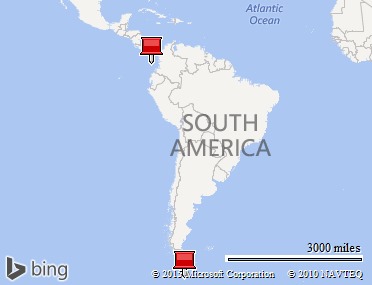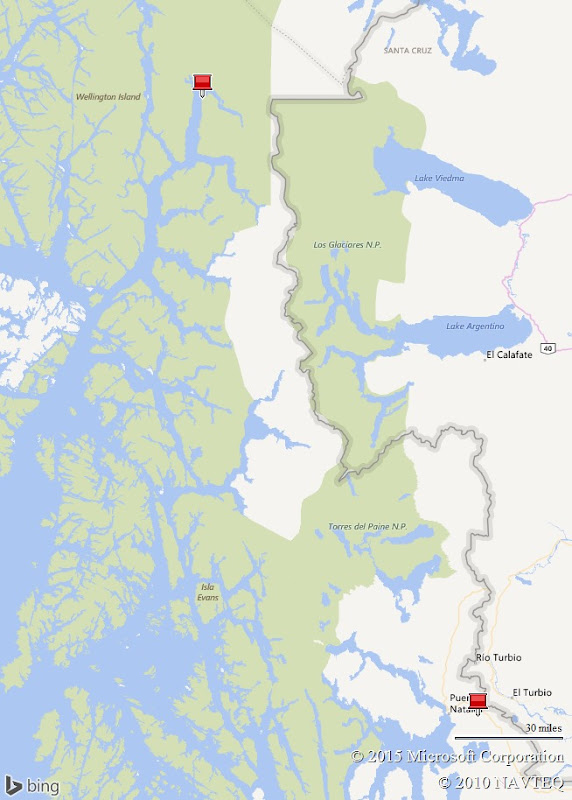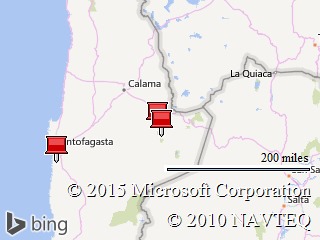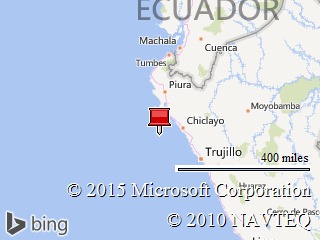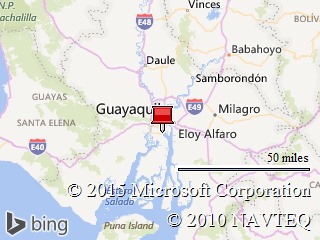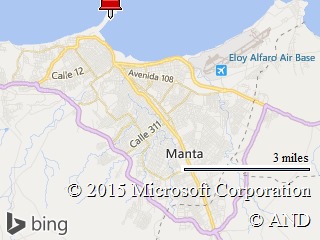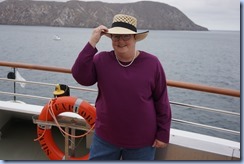Retrospective On One Of Our Best Ever Adventures
When our ship reached Ushuaia, Argentina, all of us who were leaving that day were met by a bus, driven to a parking area near the city and given an hour to explore on our own before going to the airport for our charter flight to Buenos Aires. Having been there several times, Lisa and I looked out the bus at a windy, cold and drizzling day and decided we would just stay on the warm bus and talk. As we did, we both realized that we had just been party to a truly incredible experience, and that leaving my final blog as a "Whoops" simply would not be sufficient. So, please permit me to finish the end of our trip, and then share a perspective that was easy to lose until we looked in the rearview mirror--so to speak.
After our exciting day at Torres Del Paine National Park, we left from Puerto Natales and headed south winding through the Chilean fjords. We once again had to traverse the extremely narrow White Narrows, but this time was even more of a challenge for the Captain since the winds were quite strong. The only way in which he could guarantee sufficient control of the ship was to make the transit at a rather high speed which simply was incredible. The fjords continued to offer one amazing sight after another until I reached the point of being too tired to take another picture. I did, however, go up on deck as our ship sailed past the ruins of a cargo ship which had run high aground in the late 80's in order to see something that you normally don't get to witness. We spent all day of the 11th of November in the fjords with the exception of a two hour window when we had to venture out to the open water. Let me tell you that was a rough two hours, but thanks to warnings from the crew, we got everything secured in the cabin beforehand. Even so, sleeping was nearly impossible.
The next day, we docked at Punta Arenas which is the southernmost city in Chile. While the ship offered an all day tour to a local estancia, or ranch, Lisa and I opted to have a private three hour tour of the city itself. Once again, we both continued to be impressed with southern Chile. The city was beautiful, mostly clean, and appeared to have just about anything you might find at home. It was a typical day in Patagonia, meaning that you can have four seasons of weather within one day. We began the day with a beautiful rainbow, but along the way, we had cloudy overcast skies with ferocious winds. In fact, in the downtown square, the city had actually strung ropes between lampposts and trash bins in order for people to have something to hold onto. In our three hours, we visited a beautiful old Cemetery(yes, a cemetery of all places), an outdoor nautical museum with replicas of old sailing ships, a Cathedral, and an old historic home that is now a municipal museum. In the process, we walked around the main square, and literally got blown off our feet before returning "home" to the warm comfort of our ship.
Our final day was about as picturesque as it can get. While we were spending time trying to cram everything back into our suitcases, not to mention figuring out how to bring home all the items Lisa purchased, (remember the Panama Hat?), we kept the curtains to our room wide open to enjoy the spectacle of the Chilean fjords which seemed to parade by in an endless procession of glaciers and snowcapped mountains. In late afternoon, the ship traveled up a dead end fjord in order to approach yet another glacier, and to provide us with a surprise opportunity to once again enjoy a 90 minute zodiac ride up close and personal with the beast. For several reasons we opted to play hooky, and instead took a nap. For one thing, we were just about all packed which included all our warm arctic type gear, and for another, it was cold, and of course windy with a little drizzle, sleet, and snow thrown in. No, for the tired old intrepid travelers, it was a time to pass this one by.
While we tried to take a nap, it was obvious that because of the strong winds, the ship was having some difficulty holding position with simply an anchor, so the engines and thrusters were constantly coming to life. Additionally, I kept having dreams that ice was hitting our hull, but when I awoke I found that it was no dream. Chucks of the glacier were being driven down the fjord and striking our ship on the way. What a way to end the voyage.
In the end, Lisa and I found ourselves huddled in our bus, having departed the ship with tears in our eyes. There were so many of the crew who wanted to give us hugs and well wishes as we left that it was in many ways a sad occasion. That little ship and its really fine crew had been our home for over a month, and in retrospect, what a month it had been. Lisa says that this was her BEST cruise ever. So, let me pause for just a minute to pull together an incredible adventure.
Thirty six days earlier we got to drive the length of the Panama Canal in a car in order to join our new home, the Silver Explorer in Colon, Panama. Let us not forget the pure drama of Lisa trying to find a bra on a Sunday in a country in which English is not widely spoken, and the gracious services, so to speak, which she received from our driver. Our day-long cruise through the Canal itself was as always hot, humid, and full of mosquitoes.
With not so much as a day to catch our breath, we were riding in the little zodiacs on the rising tide for 14 miles into the Panamanian rainforest to visit a native village that rarely sees outside visitors. It was like a warp in time. Getting back to the ship, we barely had time to get ready for "recap and briefing" before attending the Captain's welcome dinner. But, no rest for the weary because the very next day we are off to visit a small town, or village really, in Columbia. Still it is hot, humid, and we found ourselves going through our light microfiber clothes and insect repellent. Don't forget it was in that town that I was kidnapped! Well, in a way I was.
Next thing you knew we are off to Isla Gorgona, a UNESCO World Heritage Site that I had never even heard of, but was previously home to an infamous prison in Columbia, which is now a National Natural Reservation Park complete with gigantic Boa Constrictors - hence the need for the required rubber boots. Now you can't get this exotic stuff on a traditional cruise, that's for sure!
We then crossed the equator which required the traditional visit by King Neptune, followed the next day by a visit to Manta, Ecuador. Here our entire environment changed. Gone were the moist tropical rainforests, to be replaced by a very dry terrain, combined with moderate temperatures, and no humidity. We were now under the influence of the giant Humboldt Current. And, who can forget "The Mad Hatter" escapade because it was here, that against all my pleadings, Lisa just had to buy a beautiful Panama Hat. Now how in the hell she was supposed to get that home was beyond me, but while it was a real pain, it is now safely home in Kansas City. By the way, remember that Panama Hats actually are made in Ecuador - go figure?
Our first cruise thus ended in the city of Guayaquil, Ecuador, home to the giant iguanas which dominated the town square. Imagine, we have cute little squirrels, and they have big ugly iguanas - I'll take the squirrels any day.
So, our second cruise started with our ship being held for ransom by a bunch of "guano miners" on the tiny island of Lobos de Tierra. Recall that it took four hours of negotiations and a free lunch before they finally relented and we were allowed to go ashore to visit the nesting colonies of the Blue-footed Booby. Let's get real here!
Finally reaching Peru proper, our ship docked at the city of Salaverry, and then we drove into the historic city of Trujillo, where in my opinion I had never set foot. Well, I was mistaken, but in all honesty, what we came to visit this day was not even known when I was there around 1975. We came to visit the ancient ruins of an Incan city named El Brujo, a complex of structures which rival anything that can be seen in ancient Egypt. The nearby ruins of Chan-Chan that I had come to see way back when, was hardly worth a mention today. Our next stop was at the port city of Lima where we spent an afternoon in a museum, but one of the highlights of this cruise was our flight over the famous Nazca Lines in the desert of southern Peru near the town of Paracas. This is one experience which I have had on my bucket list since I first learned about the famous geoglyphs when in High School. I was not disappointed, although my pictures of the drawings leaves a lot to be desired, the image in my mind is priceless. But as they say, there is no rest for the weary, because barely had we recovered before we were subjected to two grueling days of overland travel and adventure, back to back.
Our first big outing lasted only 10 hours, and had us driving into the Peruvian mountains to visit the UNESCO Historical Center of Arequipa. How can I ever forget Arequipa - for it is here that I became locked into the bathroom of our bus, and barely missed spending lunch sitting in the smelly little room fuming. My best memories of the town included our visit to a monastery which dated from 1579, and that today offers a rare glimpse into the monastic life of days' gone by.
And how can I ever forget our 16.5 hour bus ride to the top of the world the following day! We found ourselves literally on top of the world at the Atacama Desert, which is the driest place on earth. The landscape is unlike any I have ever seen before. Surrounded by snow capped mountains on all sides, it is said that the terrain here is the most like that of Mars of any place on earth. I'll leave it to my pictures to try and convey the awesome beauty of the valley, but I will never forget ending our day high atop an overlook of the Valley of the Moon while the sun set. I mean, it just does not get any better, really.
If you can believe it, that basically ended our second cruise - we were only 2/3 of the way through our incredible journey. Having been to Valparaiso, Chile before, recall that Lisa and I could not make up our minds about going ashore during turnaround day - so we started, then stopped, then started again, and in the end, went to take a nap.
At this point, I am thinking there can't be much more to see on our cruise down the coast of Chile, but as usual, I was wrong. What followed was four days of non-stop adventure that left Lisa and I exhausted. We stopped at Niebla, which was the gateway to the interior of Chile and a lovely community called Valdivia which was founded by Germans. As we were to learn, this was our first real welcome to the charm of southern Chile. It was followed by our visit to Puerto Montt, and a really long day driving into the Lakes District to see the breathtaking vistas created by magnificent lakes which were surrounded by snow capped volcanoes, one of which had erupted just months before and which was still smoking. We drove up the side of a volcano nearby, and Lisa and I rode the chair lift half way up, which was all the time we had. We made it back to the ship tired and weary only to learn the next day would be a 7am departure because we were going to take a local ferry over to the island of Chiloe. The island is a UNESCO World Heritage Site because it is home to over 150 wooden churches some dating back to 1743. To say the island was "quaint" would be an understatement, and here again, I had never even heard of it.
Finally we get a day to catch our breath before the following day coming up to the face of the Pio XI Glacier, which is enormous. The face of the glacier runs for over two miles. Because the winds were howling, the water rough, and it was sleeting, I decided to just stay on the ship and forego a 90 minute ride along the glacier in a little zodiac. You think Lisa would listen to reason - hell no! So, I had no choice but to get all dressed up to go with her. Well, once again she was right. I got to witness several new things including a giant piece of the glacial wall collapsing right in front of us, preceded by a front of "Rolling Thunder." Indeed our little group with but a single clap brought down a massive chunk of ice with a resounding thunderous roar and a small tsunami afterwards. Well, maybe it was not exactly our clap, but it looked that way.
At this point, I figured that there was nothing left south in Chile, but as usual I was wrong. We visited what Lisa calls "the most beautiful place on Earth" the Torres Del Paine National Park. Frankly, she is pretty much right as my pictures will show. Once again, I had never heard of this place so the majesty of the place took me completely by surprise. After our long day, the ship entered the Chilean fjords, which is pretty much where this blog started. Glaciers, beautiful mountains, and finally the southern-most city on the planet, Ushuaia, Argentina. To go south is to go to Antarctica.
I think you can see why sitting in that bus in Ushuaia over 7,000 miles from home, we felt that looking back and pulling the entire incredible experience together was worth yet another blog.
We are now home, and that was not really a bad experience except for the fact that security was tighter than I have ever seen it at every point. We flew on LAN from Ushuaia to Buenos Aires on a Charter arranged by Silversea. We landed at the domestic terminal and needed a transfer to the International Terminal which was about an hour away. From there we caught a late departing Delta flight directly into Atlanta arriving early on Sunday. There we cleared Customs and Immigration, grabbed a bite to eat, and got on a flight directly to Kansas City. Let me tell you, it feels good to be home. But, we are both a little sad at leaving behind so many friends and great adventures; it still is good to come home!
I do hope everyone has enjoyed this trip, and that you will stay tuned for the next adventure of The Globe-Trotters.
Jim

